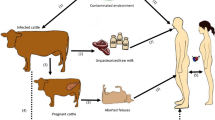Abstract
OBJECTIVE: To determine if antibiotic prophylaxis following a deer tick bite is effective in reducing the risk of developing Lyme disease.
DESIGN: Meta-analysis of published trials.
DATA IDENTIFICATION: Clinical trials were identified by a computerized literature search of MEDLINE and by an assessment of the bibliographies of published studies.
STUDY SELECTION: Trials were included in the analysis if their patients were randomly allocated to a treatment or control group, enrolled within 72 hours following anIxodes tick bite, and had no clinical evidence of Lyme disease at enrollment. Three trials were selected for review after inclusion criteria were applied.
DATA EXTRACTION: Data were extracted for details of study design, patient characteristics, interventions, duration of therapy, and number of adverse events in each arm of therapy.
RESULTS OF DATA SYNTHESIS: Among the 600 patients withIxodes tick bites, the rate of infection in the placebo group was 1.4%. In contrast, patients who received antibiotic prophylaxis had a 0% infection rate. The pooled odds ratio, comparing prophylaxis to placebo, was0.0 (95% confidence interval 0.0, 1.5) (p=.12).
CONCLUSIONS: The available evidence to date suggests that the routine use of antibiotic prophylaxis for the prevention of Lyme disease remains uncertain. Meta-analysis of the controlled trials failed to establish definitive treatment efficacy owing to the small sample size of the combined trials and the low rates of infection following a deer tick bite. A larger randomized trial is needed to demonstrate definitively that prophylaxis is more effective than placebo in reducing the risk of early Lyme disease in endemic areas.
Similar content being viewed by others
References
Lyme disease—United States, 1993. MMWR. 1994;43:564–5.
Shapiro ED, Gerber MA, Holabird NB, et al. A Controlled trial of antimicrobial prophylaxis for Lyme disease after deer tick bites. N Engl J Med. 1992;327:1769–73.
Agre F, Schwartz R. The value of early treatment of deer tick bites for the prevention of Lyme disease. AJDC. 1993;147:945–7.
Costello CM, Steere AC, Plnkerton RE, Feder HM. A prospective study of tick bites in an endemic area for Lyme disease. J Infect Dis. 1989;159:136–9.
Statistics in Epidemiologic Research Corporation. EGRET statistical software (version 0.26.6) Seattle, Wash: SERC Inc; 1991.
Vaitkus PT, Berlin JA, Schwartz JS, Barnathan ES. Stroke complicating acute myocardial infarction: a meta-analysis of risk modification by anticoagulation and thrombolytic therapy. Arch Intern Med. 1992;152:2020–4.
Gardner MJ, Gardner SB, Winter PD. Confidence Interval Analysis Microcomputer Program, Version 1.1. London: British Medical Journal; 1991.
Falco RC, Fish D. Ticks parasitizing humans in a Lyme disease endemic area of southern New York state. Am J Epidemiol. 1988;128:1146–52.
Weber K, Preac-Mursic V, Neubert U, et al. Antibiotic therapy of early European Lyme borreliosis and acrodermatitis chronica atropicans. Ann NY Acad Sci. 1988;539:324–45.
Nowakowski J, Nadelman RB, Forseter G, McKenna D, Wormser GP. Doxycycline versus tetracycline therapy for Lyme disease associated with erythema migrans. J Am Acad Dermatol. 1995;32:223–7.
Hansen K, Hovmark A, Lebech AM, et al. Roxithromycin in Lyme borreliosis: discrepant results of an in vitro and in vivo animal susceptibility study and a clinical trial in patients with erythema migrans. Acta Derm Venereol. 1992;72:297–300.
Nadelman RB, Luger SW, Frank E, Wisniewski M, Collins JJ, Wormser GP. Comparison of cefuroxime axetil and doxycycline in the treatment of early Lyme disease. Ann Intern Med. 1992;117:273–80.
Pfister HW, Preac-Mursic V, Wilske B, Schielke E, Sargel F, Einhaupl KM. Randomized comparison of ceftriaxone and cefotaxime in Lyme neuroborreliosis. J Infect Dis. 1991;163:311–8.
Dattwyler RJ, Volkman DJ, Conaty SM, Platkin SP, Luft BJ. Amoxicillin plus probenecid versus doxycycline for treatment of erythema migrans borreliosis. Lancet. 1990;336:1404–6.
Weber K, Preac-Mursic V, Wilske B, Thurmayr R, Neubert U, Scherwitz C. A randomized trial of ceftriaxone versus oral penicillin for the treatment of early European Lyme borreliosis. Infection. 1990;18:91–6.
Hassler D, Zoller L, Haude M, Hufhagel HD, Heinrich F, Sonntag HG. Cefotaxime versus penicillin in the late stage of Lyme disease—prospective, randomized therapeutic study. Infection. 1990;18:16–20.
Caperton EM, Heim-Duthoy KL, Matzke GR, Peterson PK, Johnson RC. Ceftriaxone therapy of chronic inflammatory arthritis. A double-blind placebo controlled trial. Arch Intern Med. 1990;150:1677–82.
Steere AC, Green J, Schoen RT, et al. Successful parenteral penicillin therapy of established Lyme arthritis. N Engl J Med. 1985;312:869–74.
Agre F, Schwartz RM. The value of early treatment for the prevention of Lyme disease. Abstract. AJDC. 1991;145:391.
Nadelman RB, Forseter G, Horowitz H, et al. Natural history of patients bitten by Ixodes dammini in Westchester County, NY. In: Program & Abstracts of the 5th International Conference on Lyme borreliosis. Washington, DC: Federation of American Societies for Experimental Biology; 1992:A60. Abstract.
Fleiss JL. Statistical Methods for Rates and Proportions. 2nd ed. New York, NY: John Wiley and Sons; 1981;33–49.
Gilman AG, Goodman LS, Rail TW, Murad F. The Pharmacologic Basis of Therapeutics. 7th ed. New York, NY: MacMillan Publishing Co; 1985.
Author information
Authors and Affiliations
Additional information
This study was supported in part by grants from the National Institute of Arthritis and Musculoskeletal and Skin Diseases (RO1-AR41508 and RO1-AR43135), the Centers for Disease Control and Prevention (Cooperative Agreements U50/CCU 21280 and U50/CCU 210286), and from the new York State Department of health, Tick-Borne Disease Institute (C-011001). The contents of this report are solely the responsibility of the authors and do not necessarily represent the official views of any of the above agencies.
Rights and permissions
About this article
Cite this article
Warshafsky, S., Nowokowski, J., Nadelman, R.B. et al. Efficacy of antibiotic prophylaxis for prevention of lyme disease. J Gen Intern Med 11, 329–333 (1996). https://doi.org/10.1007/BF02600042
Issue Date:
DOI: https://doi.org/10.1007/BF02600042




